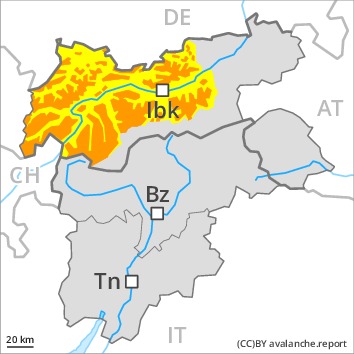
Danger level
 | 2200m
|
Avalanche Problem
 | | Persistent weak layer |
|  | |  |
 | | Wind-drifted snow |
|  | |  |

Wind slabs and weakly bonded old snow represent the main danger.
Weak layers in the old snowpack can be released by individual winter sport participants. Caution is to be exercised in particular on steep shady slopes above approximately 2200 m, as well as on steep sunny slopes above approximately 2600 m, also in areas where the snow cover is rather shallow, as well as at transitions from a shallow to a deep snowpack, when entering gullies and bowls for example. In very isolated cases avalanches are large.
The somewhat older wind slabs are to be evaluated with care and prudence, in particular adjacent to ridgelines and in gullies and bowls above approximately 2200 m. The fresh and somewhat older wind slabs are covered with new snow in some cases and therefore difficult to recognise. Caution is to be exercised in areas close to the tree line. The more recent wind slabs are lying on surface hoar in some places.
On steep grassy slopes gliding avalanches are possible, in particular medium-sized ones, especially on very steep sunny slopes below approximately 2600 m.
The current avalanche situation calls for experience in the assessment of avalanche danger and careful route selection.
Snowpack
dp.6: cold, loose snow and wind
dp.8: surface hoar blanketed with snow
Towards its surface, the snowpack is fairly homogeneous and has a loosely bonded surface. In the last few days sometimes avalanche prone wind slabs formed in all aspects, in particular on near-ridge shady slopes. The wind slabs are lying on surface hoar in some places in areas close to the tree line.
The old snowpack will be unfavourable in some places. Towards its base, the snowpack is faceted and weak. Whumpfing sounds and the formation of shooting cracks when stepping on the snowpack are a clear indication of a weakly bonded snowpack.
Tendency
Hardly any decrease in danger.
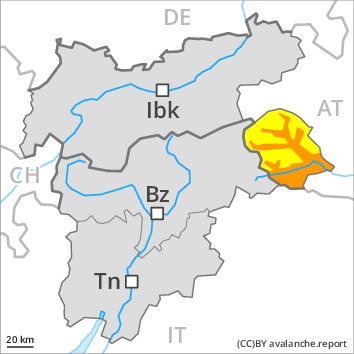
Danger level
 | 2600m
|
Avalanche Problem
 | | Gliding snow |
|  | |  |
 | | Wind-drifted snow |
|  | |  |

Caution is to be exercised in areas with glide cracks. Wind slabs require caution.
The danger of gliding avalanches will persist. On very steep grassy slopes and on sunny slopes more gliding avalanches are possible, even quite large ones. Exposed parts of transportation routes can be endangered occasionally especially in the regions with a lot of snow. Areas with glide cracks are to be avoided.
The wind slabs of last week must be evaluated with care and prudence in particular on west to north to east facing aspects. These are lying on the unfavourable surface of an old snowpack in particular on near-ridge shady slopes, caution is to be exercised also in areas close to the tree line. The more recent wind slabs are lying on surface hoar in some places.
Snowpack
dp.2: gliding snow
dp.6: cold, loose snow and wind
Towards its surface, the snowpack is fairly homogeneous and has a loosely bonded surface. In the last few days sometimes avalanche prone wind slabs formed in all aspects, in particular on near-ridge shady slopes. The wind slabs are lying on surface hoar in some places in areas close to the tree line.
The old snowpack will be unfavourable in some places. Towards its base, the snowpack is faceted and weak. Weak layers near the ground can still be released in very isolated cases.
Tendency
Hardly any decrease in danger.
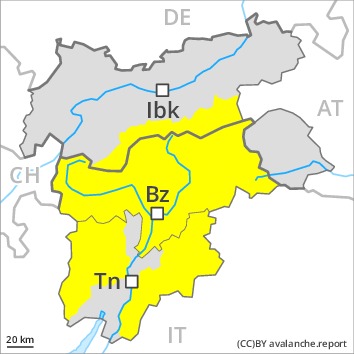
Danger level
 | treeline
|
Avalanche Problem
 | | Wind-drifted snow |
|  | |  |
 | | Gliding snow |
|  | |  |

Old wind slabs are to be evaluated critically. Areas with glide cracks are to be avoided as far as possible.
In the last few days the natural activity of avalanches has appreciably decreased. The sometimes large wind slabs of last week must be evaluated with care and prudence in particular on west to north to east facing aspects above the tree line. They are in some cases deep and can be released by large loads in particular.
On very steep grassy slopes and on sunny slopes gliding avalanches are possible, even quite large ones. Exposed parts of transportation routes can be endangered occasionally especially in the regions with a lot of snow. Areas with glide cracks are to be avoided.
In some places avalanches can be triggered in deep layers of the snowpack and reach large size in isolated cases. This applies in case of releases originating from very steep starting zones at high altitudes and in high Alpine regions that have retained the snow thus far, especially at transitions from a shallow to a deep snowpack. This applies in particular in case of a large load.
Snowpack
dp.2: gliding snow
dp.6: cold, loose snow and wind
The snowpack will be quite well bonded. More recent wind slabs are to be found in particular in gullies and bowls, and behind abrupt changes in the terrain. In some cases the various wind slabs have bonded poorly together. This applies at high altitudes and in high Alpine regions. Towards its surface, the snowpack is soft and its surface consists of surface hoar. Faceted weak layers exist deep in the old snowpack especially at high altitudes and in high Alpine regions. Towards its base, the snowpack is moist. This applies especially at low and intermediate altitudes.
Tendency
The avalanche danger will persist. Gliding avalanches can be released at any time of day or night.
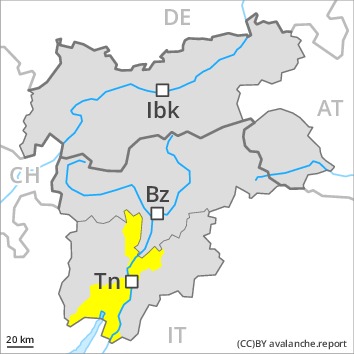
Danger level
Avalanche Problem
 | | Gliding snow |
|  | |  |
 | | Wind-drifted snow |
|  | |  |

Wind slabs are to be evaluated with care and prudence. More gliding avalanches are possible.
Individual gliding avalanches are possible in the afternoon, even medium-sized ones.
The fresh wind slabs are to be evaluated with care and prudence in particular on west to north to east facing aspects above the tree line. The number and size of avalanche prone locations will increase with altitude.
Ski touring calls for experience in the assessment of avalanche danger and careful route selection.
Snowpack
dp.2: gliding snow
The covering of new snow is fairly homogeneous and has a loosely bonded surface. Towards its base, the snowpack is moist, in particular at low and intermediate altitudes. Naturally triggered avalanches and snow profiles have confirmed this situation. As a consequence of the moderate wind, snow drift accumulations formed during the last few days, in particular adjacent to ridgelines and in gullies and bowls. This applies above the tree line.
Tendency
The avalanche danger will persist.
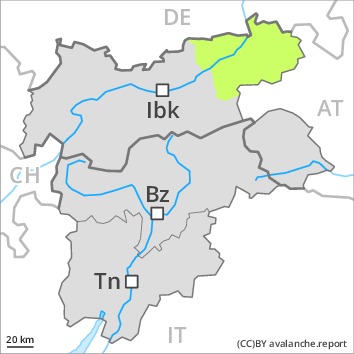
Danger level
 | 2000m
|
Avalanche Problem

Wind slabs require caution.
The somewhat older wind slabs represent the main danger. They can be released, especially by large additional loads, in particular on northwest to north to northeast facing aspects at high altitude. They are mostly small.
Snowpack
dp.6: cold, loose snow and wind
dp.8: surface hoar blanketed with snow
In the last few days sometimes avalanche prone wind slabs formed at high altitude. The old snowpack is weak in some cases, especially on steep shady slopes at high altitude. At low and intermediate altitudes a little snow is lying. The snowpack is soft and its surface consists of surface hoar, in particular in areas close to the tree line. The fresh wind slabs are lying on surface hoar in some places.
Tendency
The avalanche danger will persist.





















